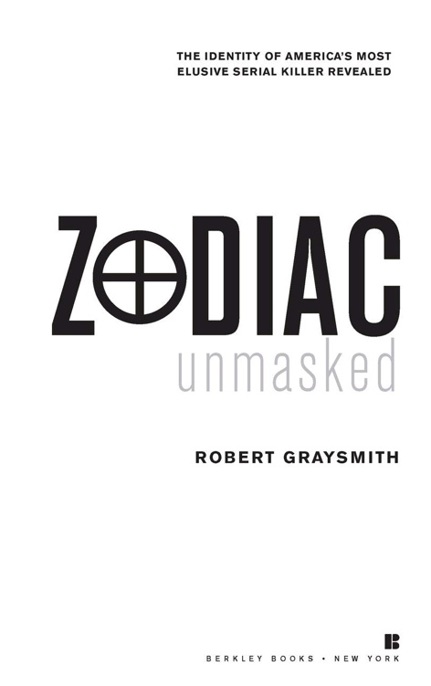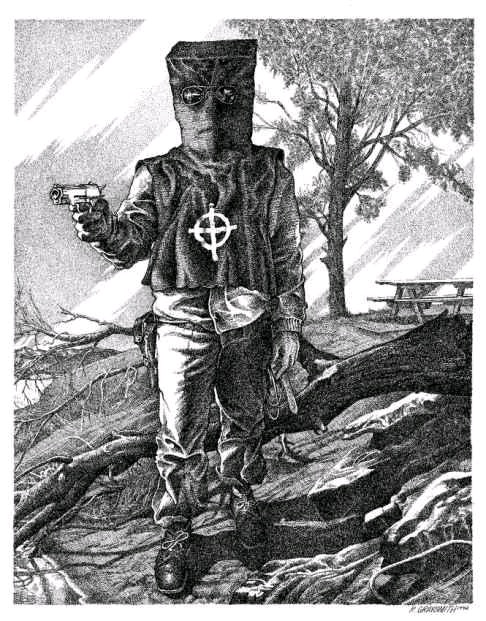Zodiac Unmasked
Authors: Robert Graysmith
Tags: #True Crime, #Murder, #Serial Killers, #Fiction, #General


Table of Contents
Title Page
Copyright Page
Dedication
Acknowledgements
Introduction
Chapter 1 - zodiac
Chapter 3 - arthur leigh al en
Chapter 4 - arthur leigh al en
Chapter 5 - robert domingos and linda edwards
Chapter 6 - avery and the dark al ey
Chapter 7 - arthur leigh al en
Chapter 8 - arthur leigh al en
Chapter 9 - policeman and sailor
Chapter 10 - the devil
Chapter 11 - atascadero
Chapter 13 - the voice of zodiac
Chapter 15 - arthur leigh al en
Chapter 16 - arthur leigh al en
Chapter 18 - arthur leigh al en
Chapter 19 - zodiac’s “dangerous game”
Chapter 20 - arthur leigh al en
Chapter 21 - zodiac at treasure island
Chapter 22 - arthur leigh al en
Chapter 23 - arthur leigh al en
Chapter 25 - arthur leigh al en
Chapter 26 - zodiac I returns
Chapter 27 - the big tip
Chapter 28 - the search
Chapter 29 - bel i
Chapter 30 - media starr
Chapter 31 - jack zodiac
Chapter 32 - the german hippie
Chapter 33 - zodiac
Chapter 34 - zodiac
Chapter 35 - the conference
Chapter 37 - arthur leigh al en
Chapter 38 - the city at the bottom of the lake
Chapter 39 - unmasked
appendices
sources
selected references
index


A Berkley Book
Published by The Berkley Publishing Group
A division of Penguin Putnam Inc.
375 Hudson Street
New York, New York 10014
This book is an original publication of The Berkley Publishing Group.
Copyright © 2002 by Robert Graysmith.
All rights reserved.
This book, or parts thereof, may not be reproduced in any form without permission.
BERKLEY and the “B” design are trademarks belonging to Penguin Putnam Inc.
Visit our website at
www.penguinputnam.com
Library of Congress Cataloging-in-Publication Data
Graysmith, Robert.
Zodiac unmasked : the identity of America’s most elusive serial killer revealed /
Robert Graysmith.
p. cm.
Includes bibliographical references and index.
eISBN : 978-1-440-67746-5
1. Starr, Robert Hall. 2. Serial murders—California—San Francisco Bay Area.
3. Serial murderers—California—San Francisco Bay Area. 4. Serial murder
investigation—California—San Francisco Bay Area. I. Title.
HV6534.S3 G73 2002
364.15’23’0979461—dc21
2001058968
Most Berkley Books are available at special quantity discounts for bulk purchases for sales promotions, premiums, fund-raising, or educational use. Special books, or book excerpts, can also be created to fit specific needs.
For details, write: Special Markets, The Berkley Publishing Group, 375 Hudson Street, New York, New York 10014.
http://us.penguingroup.com
to
JANE
acknowledgments
Al the material in this book is derived from official records or interviews I’ve conducted over a thirty year period in my search for Zodiac. My
heartfelt thanks to Inspector Dave Toschi, Detective George Bawart, and the editorial, legal, and production staff of this book: Gary Mailman, Liz
Perl, Hil ary Schupf, Heather Conner, Jil Boltin, Pauline Neuwirth, Esther Strauss, and especial y, Natalee Rosenstein, my editor.

Zodiac in Costume
by Robert Graysmith.
Author’s line-cut il ustration of Zodiac in costume at Lake Berryessa.
Zodiac’s unmasked features first came into focus one blazing summer day upon the crystal face of a watch. The detectives inside the cramped
office studied the large, expensive timepiece on the wrist of their prime suspect with dread. Such a commonplace object should not arouse fear—
yet it did. It had taken them almost three years to winnow 2500 suspects down to a handful, among them a man named Starr. Now they saw Starr’s
broad, smiling face reflected in that watch and they knew. The watch had been a catalyst for murder. Its stark black and white markings had inspired
an unprecedented reign of terror. Its logo had given the kil er his symbol, a crossed circle, like a gun sight, and his name—Zodiac.
After Jack the Ripper and before Son of Sam there is only one name their equal in terror: the deadly, elusive, and mysterious Zodiac. Since 1968
the hooded murderer had terrified San Francisco and the Bay Area with a string of cold-blooded kil ings. He hid his true features beneath a black
homemade executioner’s hood, emblazoned in white with his symbol. Zodiac, in taunting letters sent to newspapers, provided hidden clues to his
identity with cunning codes. “This is the Zodiac speaking,” he began as always. “By the way have you cracked the last cipher I sent you? My name
is—” His cryptograms defied the greatest code-breaking minds of the FBI, the CIA, and NSA.
To terrify the public, Zodiac employed arcane terminology and purposely misspel ed words. Sometimes he forgot himself and spel ed a word
correctly within the same letter. He used mispunctuation and un-grammatical language in his letters, yet understood subtle grammatical usages
such as “shal ” and “wil .” “I shal no longer announce to anyone when I comitt my murders,” Zodiac printed in blue felt-tip pen in November 1969.
“They shal look like routine robberies, kil ings of anger, & a few fake accidents, etc. The police shal never catch me, because I have been too
clever for them.” And Zodiac was clever, wearing glue on his fingertips to keep from leaving prints, and changing bizarre weapons with each attack.
Among his weapons were a gun that projected a beam of light so he could hunt people at night, electronic bombs in his basement (targeted for
school children), a homemade knife in a decorated scabbard, and guns of every caliber. We were al afraid. Single-winged planes trailed school
buses manned by armed guards, a reaction to Zodiac’s threat to “pick off the kiddies as they come bouncing out.” With each whispered phone cal
and cryptic message, each bloody scrap of victim’s clothing mailed to the
San Francisco Chronicle,
where I worked as a political cartoonist, a
resolve grew within me to uncover his true face.
What made Zodiac so irresistible to the human imagination was not only that he offered so many hints to his true identity, but that he was always
just out of reach. Who could forget the phone receiver, stil damp with sweat and swinging from its cord, that Zodiac had used only moments
before? He had brazenly cal ed police from a booth four blocks from their headquarters. Directly after an attack, he was compel ed to gloat,
heartlessly cal ing his victims’ families, breathing silently into the phone—as if he were about to speak his name.
We knew Zodiac, whoever he was, as a man of many parts—cryptographer, criminologist, chemist, artist, engineer, bomb-builder, poet,
weapons master, and above al a practioneer of the rope, the gun, and the knife. The tension grew as Zodiac, unquenchable in his blood lust, hinted
at previously concealed murders. Had he made a past mistake that might reveal his true face? “They are only finding the easy ones,” he wrote.
“There are a hel of a lot more down there.” Zodiac may have been referring to the October 30, 1966 murder of a Riverside, California coed. Zodiac
was drawn to attack or write on holidays—the Fourth of July, Thanksgiving, Columbus Day, Christmas, Hal oween, and Labor Day. In Southern
California a double murder on a beach on Whit Monday, a Virgin Island holiday, may have been his first, a rehearsal for a double stabbing at a lake
six years later. Zodiac had connections to the Virgin Islands, as did one of his victims.
Though highly intel igent, Zodiac was not an original man. He had stolen his image and method of murder from a watch, movies, comic strips,
and a short story. His M.O. had been laid out in advance on the pages of his favorite adventure tale. Obsessed with the idea of hunting men as
game, Zodiac stalked young couples “because man is the most dangerous animal of al to kil .” His rampages occurred on weekends at dusk or at
night under a new or ful moon. He cloaked himself in astrology (though that may have been a sham) and apparently cast his own horoscope to
determine when he struck. Or was Zodiac only “moon mad,” affected by the moon as the tides are?
Almost al the homicides attributed to him involved students kil ed in or around their cars near bodies of water and places named after water.
Water always figured in his crimes somewhere. Possibly Zodiac was a swimmer, boatman, or sailor. Whatever he was, he knew Val ejo, a Navy
town where the Northern California murders began, intimately. I was convinced Zodiac was a longtime Val ejo resident who knew his victims and
had stalked two for a period of time, one in particular.
Zodiac stil walked among us from the 1960s into the 1990s. He was not at work elsewhere. His massive ego and easily identifiable methods
would have made him known instantly. He intended to play his game of “outdoor chess” to the death and on home turf. Surviving victims and
horrified witnesses fled into hiding. Investigators themselves were fearful. In their hearts they knew there was no defense against the compulsive,
random kil er. Some eyewitnesses were never interviewed by the police or recontacted to be shown photos of suspects. I only found them decades
afterward. One had seen Zodiac unmasked and could identify him. Others had seen him cloaked in darkness, or in his hood, or at a distance. Al of
the witnesses had untapped and important information to give. The prime suspect had unique body language and, unbidden, the eyewitnesses al